Manufacture of traditional-style pickled food and grower of organic vegetables
Health Functionality of Japanese PicklesAgriculture
Health Functionality of Pickles
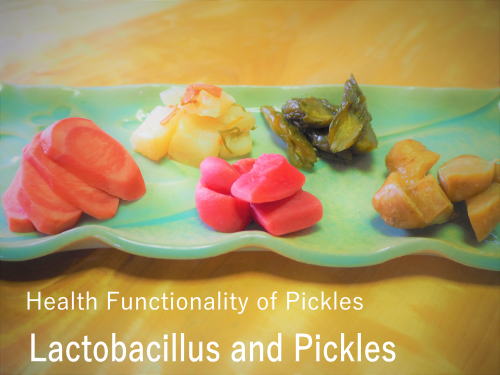
Shigeo MIYAO, Visiting Professor, Graduate School of Tokyo Kasei University 2020
Introduction
Tsukemono foods (pickled vegetables) are often avoided by consumers because
of their high salt content.
However, they have been eaten as a side dish to rice over a long period
from before the Nara Era (AD 710-794) until now (implying that tsukemono
is indispensable in Japanese food). The style of Japanese food, in principle,
is based on “ichiju-sansai” (one soup and three dishes). “Sansai” indicates
“three side dishes,” which additionally makes rice, the Japanese staple
food, delicious. In the traditional style of Japanese food passed on for
more than 1,000 years, tsukemono, also known as “Kō-no-mono,” is placed
on a table along with a bowl of rice and a soup. Rice and tsukemono are
an implicit combination indispensable in Japanese food; therefore, they
are not explicitly included in the term “ichiju-sansai.” Tsukemono is called
“Kō-no-mono” because we, the Japanese, enjoy flavor of tsukemono. It is
also called “Oshinko” (new flavor) because we enjoy its freshness.
In recent years, functional ingredients in foods, which are useful for maintaining good health with helping to keep biological regulation, have attracted public attention. In addition to the dietary fiber, tsukemono contains functional ingredients for health such as vitamins, minerals, and polyphenols, along with GABA, inulin and isothiocyanate, which have also drawn attention.
Hakko-tsukemono (fermented pickles), such as sugukizuke (pickled suguki) and shibazuke (pickled chopped vegetables), which are made through the lactic acid fermentation process, are increasingly receiving interest due to their health maintenance function because they contain a large amount of lactic acid bacteria derived from plants (so-called plant lactobacilli). For this reason, the present paper introduces the health functionality of tsukemono.
1 Dietary fiber
According to “Overview of Dietary Reference Intakes for Japanese (2010)”
specified by the Minister of Health, Labour and Welfare, dietary fiber
increases fecal volume when 20 g is consumed per day and it has an important
relationship with myocardial infarction, one of the life-style related
diseases. These guidelines indicate that the morbidity rate of myocardial
infarction is reduced when ≥24 g of dietary fiber is consumed per day,
whereas the death rate increases when <12 g of dietary fiber is consumed
per day(note 1). “Overview of Dietary Reference Intakes for Japanese (2020)”
also suggests that the ideal daily intake of dietary fiber is ≥21 g for
adult males and ≥18 g for adult females(note 2). According to “National
health and nutrition examination survey (2016),” there is a tendency toward
lower dietary fiber intake in young people, which increases as they get
older (Table 1); however, it is clear that the intake does not reach the
target values in all age brackets. Moreover, the target intake of vegetables
rich in dietary fiber is set at 350 g per day, but currently, neither males
nor females have reached the target amount (Fig. 1). For this reason, it
remains necessary for adults to take more dietary fiber from vegetables
and processed foods such as tsukemono. Especially, young people are expected
to get more dietary fiber from vegetables..
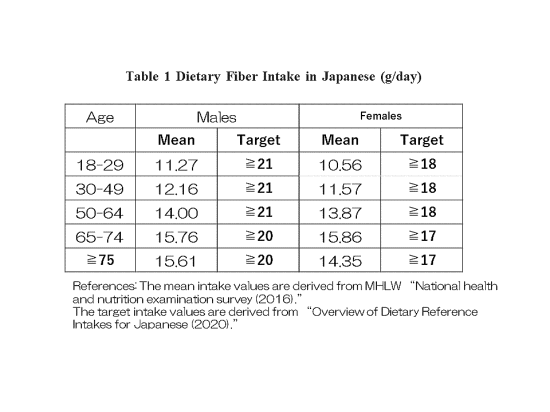
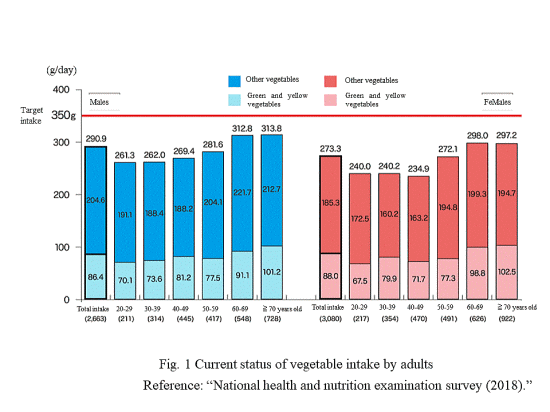
Fig. 2 shows a comparison of the dietary fiber content among fresh vegetables and vegetables processed into tsukemono. The water content in cucumbers processed into tsukemono is reduced compared with that in raw cucumbers; therefore, the dietary fiber content is relatively increased. In other words, assuming that fresh vegetables and processed vegetables (tsukemono) are eaten in the same amounts, more dietary fiber can be taken from tsukemono than from fresh vegetables. In the case of daikon (Japanese radish), more than twice as much dietary fiber can be taken from takuan (pickled daikon) than can be taken from fresh daikon. Similarly, more dietary fiber can be taken from pickled takana and hakusai (Chinese cabbage) than can be taken from their raw alternatives, provided they are consumed in the same amounts. As indicated, therefore, we can take more dietary fiber from tsukemono than from fresh vegetables. Table 2 shows the dietary fiber content of the main types of tsukemono.
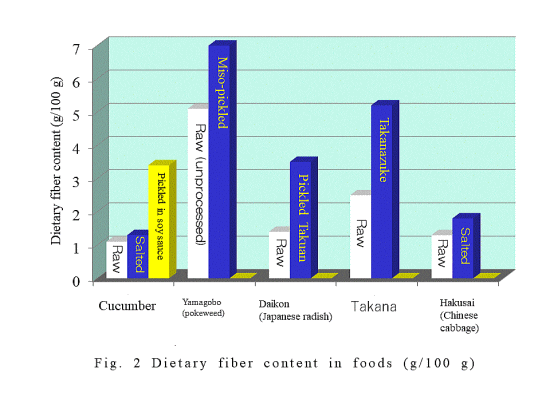
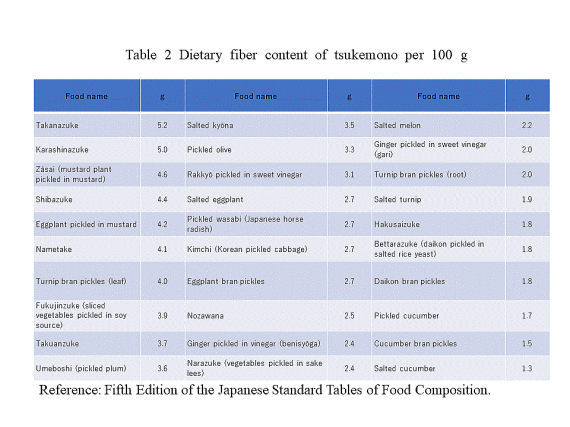
Two types of dietary fiber exist: insoluble dietary fiber and water-soluble
dietary fiber. Insoluble dietary fiber is thought to be effective for prevention
of life-style related diseases due to increase of fecal volume and stimulation
of the intestinal wall; water-soluble dietary fiber serves as a nutrient
source for intestinal bacteria and contributes to improving intestinal
flora (bacterial flora)(note 3). Recently, among various types of water-soluble
dietary fibers, inulin has especially attracted attention. Inulin is believed
to have an effect on increasing bifidobacteria, reducing blood triglyceride,
suppressing an increase in postprandial blood glucose level. As Jerusalem
artichokes contain a large amount of inulin, pickles of them have been
commercialized as tsukemono.
note 1: Reference 1
note 2: Reference 2
note 3: Numerous bacteria inhabit the human intestine. The population of
bacteria is called intestinal flora (bacterial flora). The gastrointestinal
tract is composed of the stomach, small intestine, and large intestine.
Usually, the intestinal flora indicates the florae in the large intestine
and feces (flora means “flower garden”).
2 Potassium
Fresh vegetables and tsukemono are rich in potassium, which is low in foods of animal origin. Since potassium facilitates sodium excretion and inhibits blood pressure increase, it is designated as one of six types of minerals for which “food with nutrient function claims” may be made. There is more potassium ion inside than outside the cell, and sodium ion is the opposite. Therefore, constant balance is maintained between these two ions. However, when the potassium−sodium balance is compromised, intracellular water enters the blood. As a result, the volume of extracellular fluid, including the blood, increases; in other words, the water content of the blood increases, leading to a rise in blood pressure. This mechanism is considered to be one of causal factors of hypertension. By ingesting a large amount of vegetables to take potassium into the body, excess sodium is excreted into the urine, which helps prevent hypertension. Tsukemono contains sodium in somewhat large amounts. However, it may be necessary to inform consumers that the vegetables used to make tsukemono contain abundant potassium (Potassium). Table 3 lists the potassium content of various types of tsukemono foods.
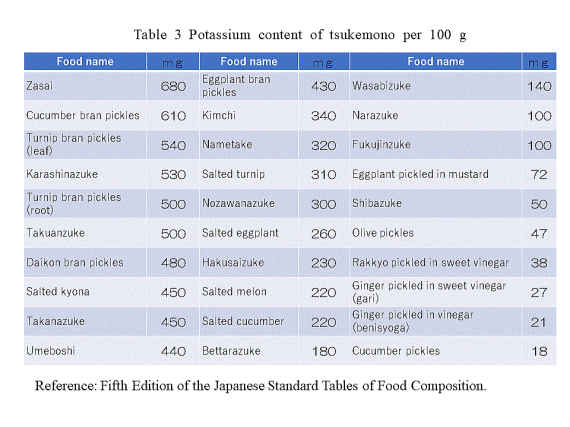
3 Functional ingredients
(1) Polyphenols
Polyphenols are well-known functional ingredients contained in vegetables and tsukemono. They are found in vegetable pigments and astringent ingredients, and anthocyan pigments such as eggplant and red turnip are typical.. It is assumed that polyphenols were produced as an evolutionally adaptation by which a biological defense mechanism was acquired for protection against enemies in harsh environments. Based on this assumption, previous studies have reported that polyphenols have actions and effects such as antibacterial activity, antioxidative effects, antiaging effects, anti-carcinogenesis, and anti-allergenic action.
(2) GABA
GABA (γ-amino acid), discovered in the brains of mammals in 1950, is an amino acid that is not an element of amino acid composition. In higher animals, GABA, which functions as an inhibitory neurotransmitter, is known for its stress reduction effect, hypotensive action, and diuretic effect. Blood pressure increases with increased activity in the sympathetic nervous system; GABA is thought to suppress activation of the sympathetic nervous system and the discharge of noradrenaline involved in vasoconstriction, thereby contributing to a decrease in blood pressure. Recently, tsukemono has been developed and commercialized using Lactobacillus with the ability to produce GABA. Fig. 3 shows an example of the trial production of senmaizuke (pickled sliced turnips) using Lactobacillus sp. L13, a high-productivity lactic acid, as a starter. As shown in the figure, the GABA yield rapidly increased from day 3. Interestingly, studies have also reported that GABA is produced in the sun-drying process of daikon(radish) (Fig. 4).
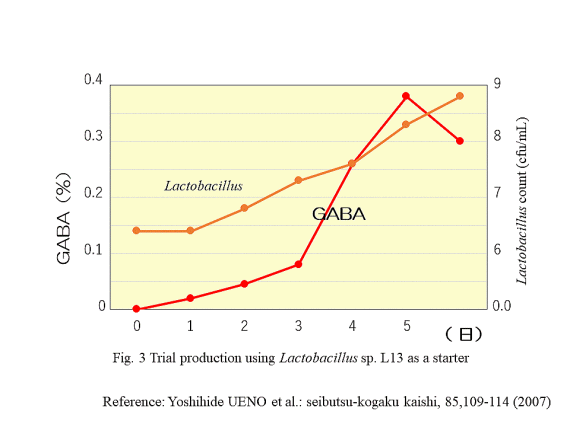
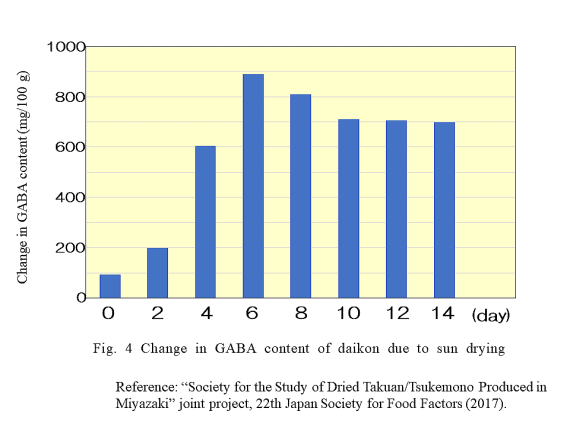
(3) Isothiocyanate
In a Japan Public Health Center-Based Prospective Study (JPHC) conducted by the National Cancer Center with 90,000 male and female voluntary participants, the relationship between intake of cruciferous vegetables (daikon(radish),hakusai(chinese radish ), leaf mustard, nozawana, cabbage, broccoli, etc.) and death rate was examined. Results showed that the all-cause death risk was 14% lower in male participants and 11% lower in female participants with the highest vegetable intake compared to those with the lowest vegetable intake (Figs. 5 and 6). One reason why consuming a large amount of cruciferous vegetables reduces the risk of death is that these vegetables contain abundant isothiocyanate and antioxidant vitamins, which suggests that they have anti-inflammatory action and antioxidative effects that help reduce the risk of death. Since most of raw vegetables used for tsukemono are cruciferous vegetables, including daikon(radish),hakusai(chinese radish ), nozawana, takana, and turnips, intake of tsukemono is also expected to help maintaining health functionality.
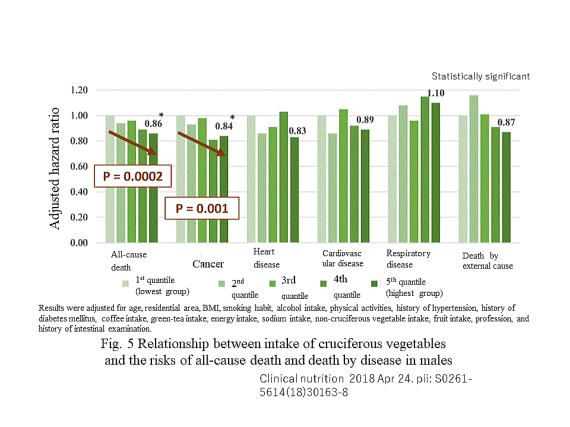
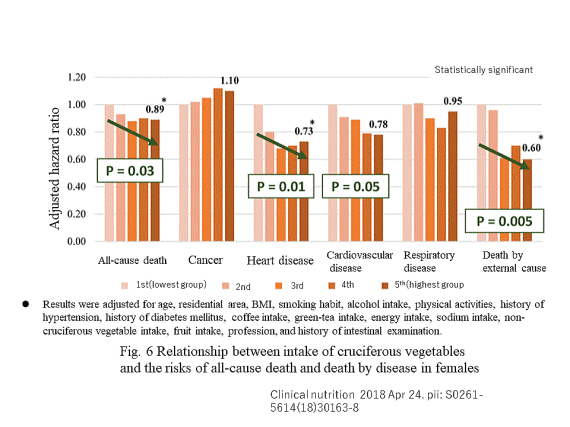
4 Lactobacillus and tsukemono
Probiotics are live microorganisms, such as well-known Lactobacillus and Bifidobacterium, which have beneficial effects on humans by improving the balance of intestinal flora. Various types of fermented tsukemono foods, including nukazuke (vegetable bran pickles), takanazuke, sugukizuke, shibazuke, akakabuzuke, sunkizuke, and kimchi (Korean pickles), are resistant to gastric acid and contain Lactobacillus capable of reaching the intestine, the so-called plant Lactobacillus(note 4), in abundance; therefore, fermented tsukemono may be defined as a probiotic food.
Lactobacillus has several actions: 1) improving bowel movements by suppressing constipation; 2) gastrointestinal regulation, which improves the intestinal environment by increasing beneficial intestinal bacteria and reducing harmful intestinal bacteria; and 3) strengthening immunity to viruses. Plant lactobacilli are known to inhabit fermented tsukemono foods at a rate of several thousand to several hundred million per gram. Table 4 summarizes the characteristics of plant lactobacilli and animal lactobacilli contained mainly in dairy products(note4). As plant lactobacilli can inhabit environments with poor nutritional composition and tsukemono foods in abundance, they are capable of growing in harsh environments with conditions such as high salt content and low pH. In other words, plant lactobacilli resistant to gastric acid has a higher survival rate in the stomach than animal lactobacilli, which increases the probability that the former reaches the gastrointestinal tract.
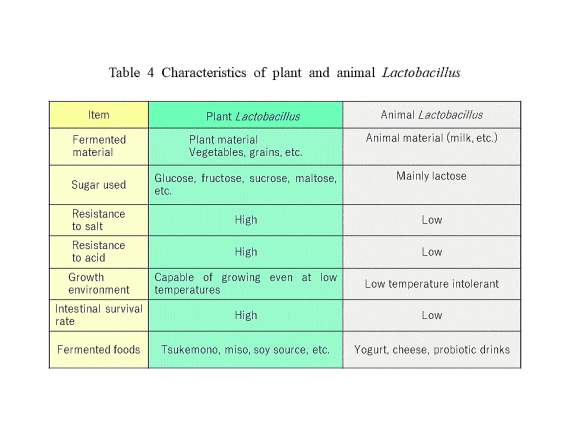
Fig. 7 shows a schematic diagram of the changes in microorganism flora commonly observed in the fermented tsukemono production process. Once lactobacilli have grown, their content in the fermented tsukemono food can reach 0.7-1.0%, resulting in extinction of miscellaneous germs. For this reason, food poisoning is almost never caused by Lactobacillus-based fermented tsukemono foods.
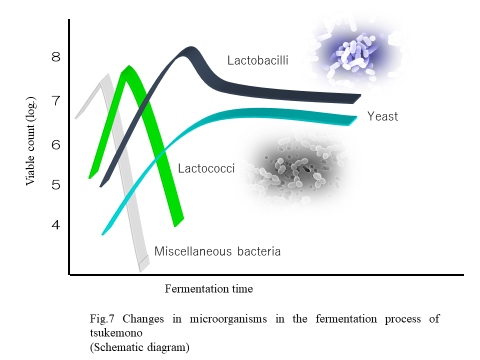
Lactobacilli with health maintenance functionality are known to grow in fermented tsukemono foods: typically, Lactobacillus plantarum and Lactobacillus brevis are involved in such functionality.
note 4: Plant Lactobacillus indicates Lactobacillus derived from plants. Animal Lactobacillus indicates Lactobacillus derived from mainly dairy products.
(1) Sugukizuke (Kyoto)
Sugukina is a native variety of turnip, which has been grown until now in Kamigamo, Kita-ku, and Kyoto-shi. In Kyoto, “suguki” indicates “sugukizuke,” the fermented tsukemono food traditionally produced in the surrounding area of Kamigamo Jinjya (Shrine). The Louis Pasteur Center for Medical Research situated in Kyoto has revealed that L. brevis isolated from “suguki” has an action in the intestinal immune system to induce the production of interferons(note 5). Interferons are proteins with antiviral activity; they are produced in vivo and studies have shown that they contribute to the activation of natural killer cells (NK cells) that play a role in protection against infections and diseases such as cancer. NK cells, one type of large lymphocytes, play an active role in in vivo immune reactions; for example, they kill cells infected with cancer and viruses. In addition, they have intestinal regulation and immunostimulatory actions(note 6). A large-scale survey of beverage products containing Lactobacillus was conducted with about 3,000 elementary school children; the children that consumed the test beverage were less likely to get influenza compared with those that did not consume the test beverage. Based on this finding, it was verified that Lactobacillus enhances the immune system and has an antiviral action on influenza(note 7).
note 5: Reference 3
note 6: to activate the immune system.
note 7: Reference 4
(2) Sunki (Nagano)
“Sunki” is a fermented tsukemono food, also known as “sunkizuke”, traditionally produced in Otaki-mura, Kaida-mura, and Mitake-mura on Kaida Kogen (plateau) at the foot of Mt. Ontake (Kiso) located in an area far from Kiso Fukushima. Pediococcus pentosaceus and Lactobacillus delbrueckii, which is a plant Lactobacillus, have been isolated from “sunki;” these bacterial species have been shown to have an immunoregulatory activity and a disease prevention effect, respectively(note 8). In recent years, the number of patients suffering from allergic diseases, such as atopic dermatitis, food allergies, and pollen allergies, has increasingly grown. These allergic diseases are induced by the development and upregulation of IgG antibodies. Given these findings, an experiment was conducted, in which P. pentosaceus isolated from “sunki” was orally administered to model mice with allergic diarrhea to verify its effectiveness in relieving this condition. Results showed that IgG antibody levels in the blood of mice was reduced and allergic diarrhea was relieved, suggesting that P. pentosaceus has an allergic disease prevention/relieving action. It has been also revealed that P. pentosaceus enhances NK cell activity(note 8) and prevents death from influenza virus in mice(note8), suggesting that P. pentosaceus also has an influenza prevention effect. On the other hand, it has been demonstrated that L. delbrueckii inhibits the growth of Helicobacter pylori and its adhesion to gastric epithelial cells. Many Japanese people are thought to have been infected with Helicobacter pylori, which is a causative bacterium of gastritis, gastric ulcers, duodenal ulcers, and stomach cancer. Based on the above-mentioned findings, L. delbrueckii is expected to prevent infection with H. pylori.
note 8: Reference 5
References
1. Ministry of Health, Labor and Welfare: “Overview of Dietary Reference Intakes for Japanese (2010)” Planning Report.
2. Ministry of Health, Labor and Welfare: “Overview of Dietary Reference Intakes for Japanese (2020)” Planning Report.
3. Tadashi YOSHIMATSU et al.: The Japanese Journal of Nutrition and Dietetics, 60 (3), 137-143 (2002).
4. Kagome News Release,Oct. 16, 2014,”It was verified that the morbidity rate of influenza was reduced by continuously taking the beverage product containing Lactobacillus brevis ・KB290 (commonly called Labre bacillus) – From the finding of a large-scaled survey conducted in the children of 15 elementary schools in Nasu Shiobara-shi, Tochigi in the flu season.
5. Takeyuki MASUDA et al.: Journal of Japan Society for Lactic Acid Bacteria,21 (1), 42-49 (2010).
Shigeo MIYAO 【Profile】
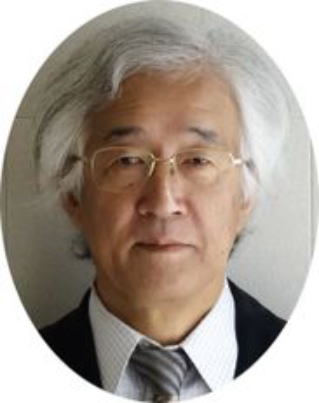 Doctor of Agriculture
Doctor of Agriculture
2008 to 2020
Professor, Food Processing Laboratory, Tokyo Kasei University
2020 onwards
Adjunct professor, Graduate School of Tokyo Kasei University
2020 to present
Adjunct professor, Department of Food Science, Sichuan University (China)
Member of Committee of Experienced People from Academic Circles Concerning Geographical Indication (GI) Prevention
Vice president, Society for Researches on Japanese Traditional Foods
Executive advisor, National Federation of Tsukemono Cooperatives
Adjunct professor, Department of Food Science, Sichuan University (China)
Member of Committee of Experienced People from Academic Circles Concerning Geographical Indication (GI) Prevention
Vice president, Society for Researches on Japanese Traditional Foods
Executive advisor, National Federation of Tsukemono Cooperatives
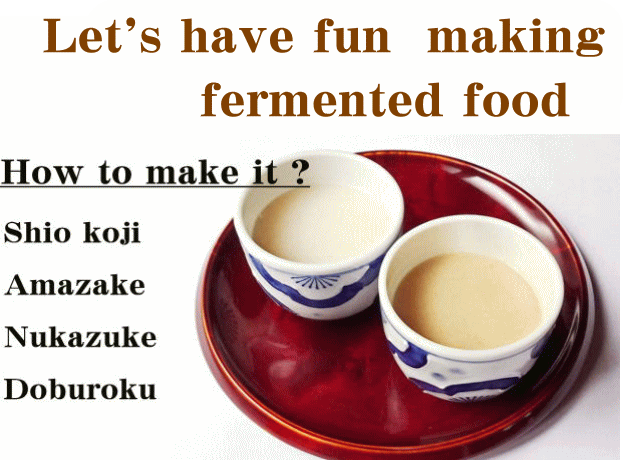
Food preservation methods
(Yasunori yoshima 2023)Preserving through acidity and temperature
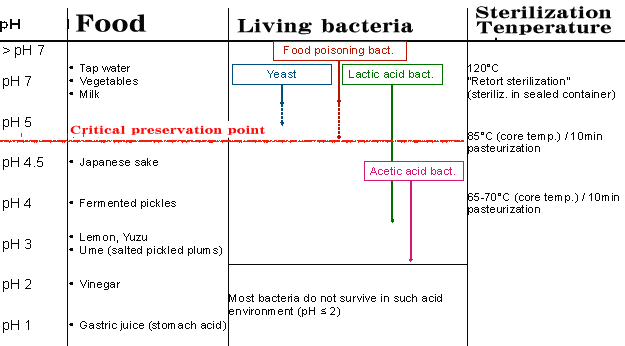
Fermented pickles
- When fermenting vegetables, lactic acid bacteria, which are naturally present in plants, animal products and in our bodies, feed on the carbohydrates from the vegetables to grow.
- As the lactic acid bacteria grow and multiply, they produce lactic acid.
- This lactic acid lowers the pH of the environment, making it more acid. This helps preserve the food by preventing the growth of undesirable bacteria. This is also what gives fermented pickles their pleasant sour taste.
Preserving through salt
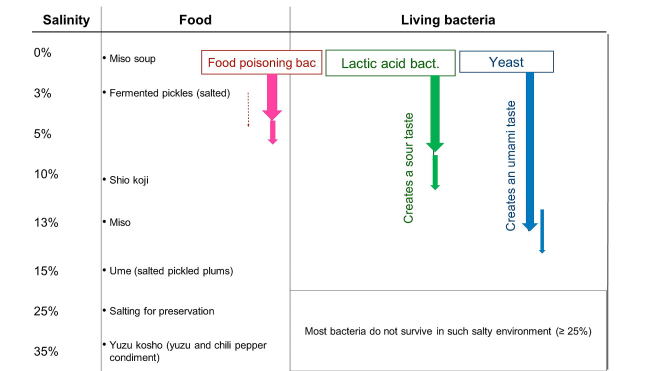
The role of salt
- Salt acts as an inhibitor to fermentation. The lower the salt content, the faster the fermentation.
- Miso with a lower salt content will allow more lactic acid bacteria to grow and will be therefore more sour.
- Above 25% salt content, most bacteria cannot survive.
From rice to alcohol ,from alcohol to vinegar
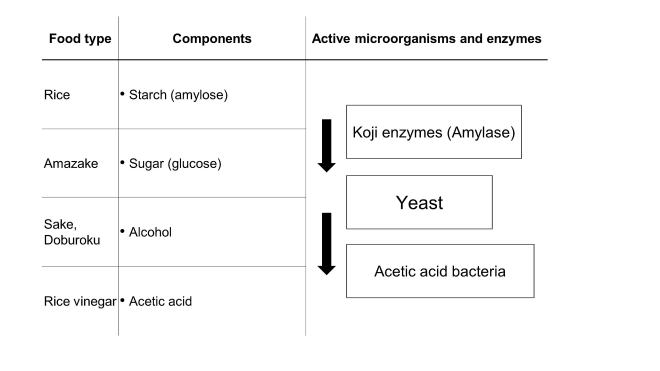
Rice transformation
- When koji enzymes break down the starch present in rice into sugar (glucose), this gives amazake, a sweet rice beverage.
- As yeast feeds on the glucose, it produces alcohol. Depending on the production method, this gives either Japanese sake or Doburoku.
- The alcoholic beverage can be either sterilised (at 85°C core temperature during 10 minutes) to be preserved, or left to be transformed into vinegar through the action of acetic acid bacteria (which transform alcohol into acid).
